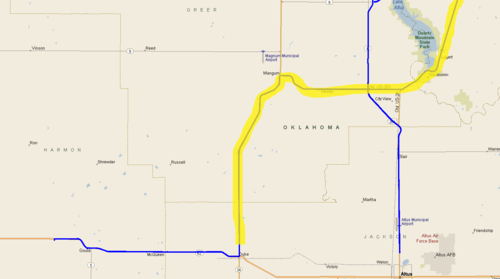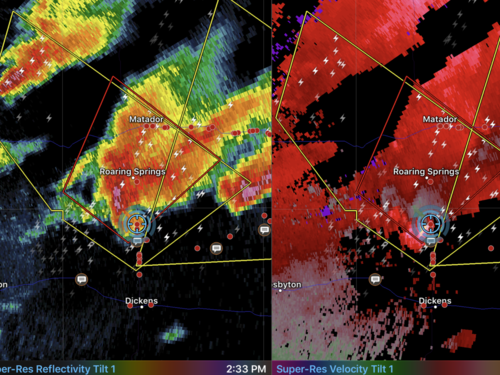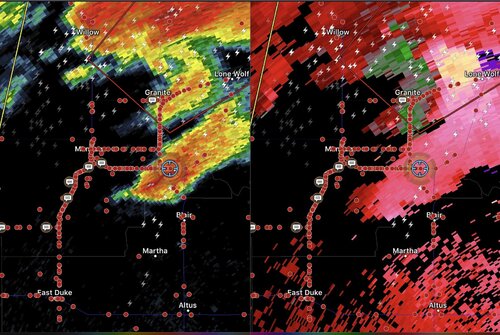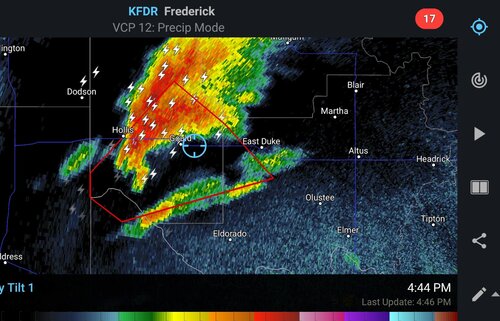Dan Robinson
EF5
OK, now that the bulk of the "mainstream" chase season is over, let me make sure I'm correct. I like to quantify these things into hard facts which I will be including on my chaser traffic web page.
We had three (3) events this year where chaser traffic reached critical levels (chase-affecting and more than just sporadic/transient jams):
May 7: Vigo Park, Texas Panhandle (northeast of Tulia): A single viable target storm emerged toward the end of this Moderate Risk event at Tulia, attracting most chasers in the Panhandle. Chasers from the northern storm in Amarillo headed to the Tulia storm. A single road through the Palo Duro canyon, Highway 207, resulted in all chasers on the storm being funneled onto two roads, east-west 146 and north-south 207. The T-intersection of these two roads was the main "choke point".
May 20: Mangum, Oklahoma: A High Risk was issued for an expected major outbreak in southern/central Oklahoma, atrracting a very large number of chasers. Instead of multiple storms, a single viable target storm evolved near Hollis, OK, attracting most chasers to it by the time it reached Mangum. I need some details from those of you who were there to fill in the blanks on where the choke points were and which highway had the worst traffic.
May 26: Lamar, Colorado: The impassable secondary roads and only one available paved highway near the storm funneled all chasers on the Lamar storm onto Highway 385 north. An accident involving chaser vehicles exacerbated the backup.
Amazingly enough, I did not encounter any of these situations - two due to factors beyond my control. On the 7th, I had to lose the storm and go to Tulia to get gas since there were no other stations on I-27 north of there. On the 20th, I got stuck on a dirt road as the storm crossed into Oklahoma, making me lose the storm and that traffic jam. On the 26th, I had given up on the Colorado target thanks to cold upstream inflow and was not there for that either, choosing instead to go to storms near Dodge City.
Nonetheless, if any of you have video of the traffic, or even better, a dashcam timelapse of the events, please let me know and I will link them on my page. I don't exclude any high traffic events, rather I aim to present an accurate, factual analysis of the chaser traffic issue.
As a reminder, the site is here:
We had three (3) events this year where chaser traffic reached critical levels (chase-affecting and more than just sporadic/transient jams):
May 7: Vigo Park, Texas Panhandle (northeast of Tulia): A single viable target storm emerged toward the end of this Moderate Risk event at Tulia, attracting most chasers in the Panhandle. Chasers from the northern storm in Amarillo headed to the Tulia storm. A single road through the Palo Duro canyon, Highway 207, resulted in all chasers on the storm being funneled onto two roads, east-west 146 and north-south 207. The T-intersection of these two roads was the main "choke point".
May 20: Mangum, Oklahoma: A High Risk was issued for an expected major outbreak in southern/central Oklahoma, atrracting a very large number of chasers. Instead of multiple storms, a single viable target storm evolved near Hollis, OK, attracting most chasers to it by the time it reached Mangum. I need some details from those of you who were there to fill in the blanks on where the choke points were and which highway had the worst traffic.
May 26: Lamar, Colorado: The impassable secondary roads and only one available paved highway near the storm funneled all chasers on the Lamar storm onto Highway 385 north. An accident involving chaser vehicles exacerbated the backup.
Amazingly enough, I did not encounter any of these situations - two due to factors beyond my control. On the 7th, I had to lose the storm and go to Tulia to get gas since there were no other stations on I-27 north of there. On the 20th, I got stuck on a dirt road as the storm crossed into Oklahoma, making me lose the storm and that traffic jam. On the 26th, I had given up on the Colorado target thanks to cold upstream inflow and was not there for that either, choosing instead to go to storms near Dodge City.
Nonetheless, if any of you have video of the traffic, or even better, a dashcam timelapse of the events, please let me know and I will link them on my page. I don't exclude any high traffic events, rather I aim to present an accurate, factual analysis of the chaser traffic issue.
As a reminder, the site is here:




